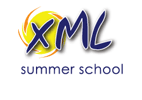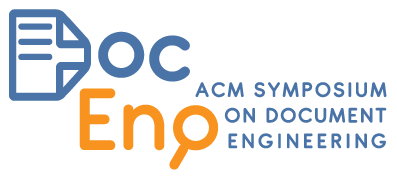Schedule for Friday
chaired by yours truly Mohamed Zergaoui (morning) and Jirka Kosek (afternoon)
| 9:00 | Registration desk opens |
| 9:30 | Opening and sponsors presentation |
| 9:40 | Refactoring (the way we talk about) CSS Rachel Andrew |
| 10:30 | A note on Editor performance Stef Busking and Martin Middel (FontoXML) |
| 11:00 | Coffee break |
| 11:30 | XSLWeb: XSLT- and XQuery-only pipelines for the web Pieter Masereeuw (Pieter Masereeuw ICT BV) and Maarten Kroon (Armatiek BV) |
| 12:00 | Design Suggestions for XML++ Svante Schubert |
| 12:30 | Things we lost in the fire Geert Bormans (C-Moria BV) and Ari Nordström (Creative Words) |
| 13:00 | Lunch |
| 14:30 | Opening of afternoon sessions |
| 14:40 | Rebuilding the Oxygen blog using XML George Bina and Radu Coravu (Syncro Soft/Oxygen XML) |
| 15:00 | Sequence alignment in XSLT 3.0 David Birnbaum (University of Pittsburgh) |
| 15:30 | Loose-leaf Formatting with CSS Tony Graham (Antenna House) |
| 16:00 | Coffee Break |
| 16:30 | Powerful patterns with XSLT 3.0 hidden improvements Abel Braaksma (Exselt) |
| 17:00 | A Proposal for XSLT 4.0 Michael Kay (Saxonica) |
| 18:00 | Closing of the day |
| 19:30 | Social dinner & DemoJam |
Session details
Refactoring (the way we talk about) CSS
Rachel Andrew
Rachel Andrew has been writing CSS for 20 years, and teaching people the things she has learned for almost as long. Since the early days of CSS, and certainly since “CSS for Layout” became a thing, we’ve been teaching CSS in pretty much the same way. Here is a block thing, here is an inline thing, this is the Box Model … and here is this weird jumping through hoops that makes a layout. It’s time for a change.
In this talk Rachel will explain how, in the last few years, CSS has been refactored to an extent that to really explain how CSS works we need to change the way we teach and talk about the language. We need to look again at what it is to learn CSS. We need to leave our old ideas behind. It is only when we do, that we will stop supporting the idea that CSS is the fragile, broken, quirky language that its detractors would like to believe.
» slides
A note on Editor performance
Stef Busking and Martin Middel (FontoXML)
A story on how the performance of Fonto came to be what it is, and how we will further improve it. This presentation will discuss a number of key performance optimizations made during the development of Fonto, a web-based WYSIWYM XML editor. It describes how the configuration layer of Fonto works and what we did to make it faster. It will also describe how the indexing layer of Fonto works and how we improve it in the future.
» Read paper in proceedings
» slides
XSLWeb: XSLT- and XQuery-only pipelines for the web
Pieter Masereeuw (Pieter Masereeuw ICT BV) and Maarten Kroon (Armatiek BV)
XSLWeb is an open source and free to use web development framework for XSLT and XQuery developers. It is based on concepts similar to frameworks like Cocoon and Servlex, but aims to be more easily accessible and pragmatic.
» Read paper in proceedings
» slides
Design Suggestions for XML++
Svante Schubert
The XML technology stack and its tool chain has been stable for decades. With this paper we suggest to take the next step forward, embracing an extended feature set specialized on highend enterprise use cases.
» slides
Things we lost in the fire
Geert Bormans (C-Moria BV) and Ari Nordström (Creative Words)
This is about all those markup consulting projects where you realise that something isn’t quite as it should be. Early on, your internal alarm bells are set off by a technology choice, legacy systems or processes, or maybe internal conflicts, and you realise there are some hard decisions to make. Yes, you have bills to pay but is this one of those projects you should stay away from… or have stayed away from in the first place?
» slides
Rebuilding the Oxygen blog using XML
George Bina and Radu Coravu (Syncro Soft/Oxygen XML)
Modern XML applications are built by connecting a number of distributed services rather than being a monolithic system. Such applications can be setup in a very short time with a small amount of effort. It is very useful to have open source examples of such applications to allow others to replicate and build a similar setup. Such an example is the new Oxygen XML blog, built using GitHub, Netlify, DITA, Oxygen XML Web Author, dynamic publishing and feedback service, made available as an open source project.
Sequence alignment in XSLT 3.0
David Birnbaum (University of Pittsburgh)
The Needleman Wunsch algorithm, which this year celebrates its quinquagenary anniversary, has been proven to produce an optimal global pairwise sequence alignment. Because this dynamic programming algorithm requires the progressive updating of mutually dependent variables, it poses challenges for functional programming paradigms like the one underlying XSLT. The present report explores these challenges and provides an implementation of the Needleman Wunsch algorithm in XSLT 3.0.
» Read paper in proceedings
» slides
Loose-leaf Formatting with CSS
Tony Graham (Antenna House)
Loose-leaf formatting is one of the hardest problems in publishing. When a loose-leaf document is updated, only the pages with changes are printed and distributed to users. The utmost care is taken to minimize the number of changed pages in any update. This session describes a loose-leaf formatting project for formatting legal document with CSS.
» slides
Powerful patterns with XSLT 3.0 hidden improvements
Abel Braaksma (Exselt)
With XSLT 3.0 slowly becoming more mainstream since its status as a Recommendation in 2017, it is now a good moment to review one of the smaller changes to the XSLT language, namely: patterns. Patterns are ubiquitous in XSLT, in fact, they are the cornerstone to successful programming in this language. This presentation is not meant as an introduction to patterns and pattern matching through xsl:apply-templates, for that other sources exist. Instead, it will focus on some of the changes in the syntax and the new additions to pattern matching rules.
» Read paper in proceedings
A Proposal for XSLT 4.0
Michael Kay (Saxonica)
This paper defines a set of proposed extensions to the XSLT 3.0 language, suitable for inclusion in version 4.0 of the language were that ever to be defined. The proposed features are described in sufficient detail to enable the functionality to be understood and assessed, but not in the microscopic detail needed for the eventual language specification. Brief motivation is given for each feature. The ideas have been collected by the author both from his own experience in using XSLT 3.0 to develop some sizable applications (such as an XSLT compiler), and also from feedback from users, reported either directly to Saxonica in support requests, or registered on internet forums such as StackOverflow.
» Read paper in proceedings
» slides












